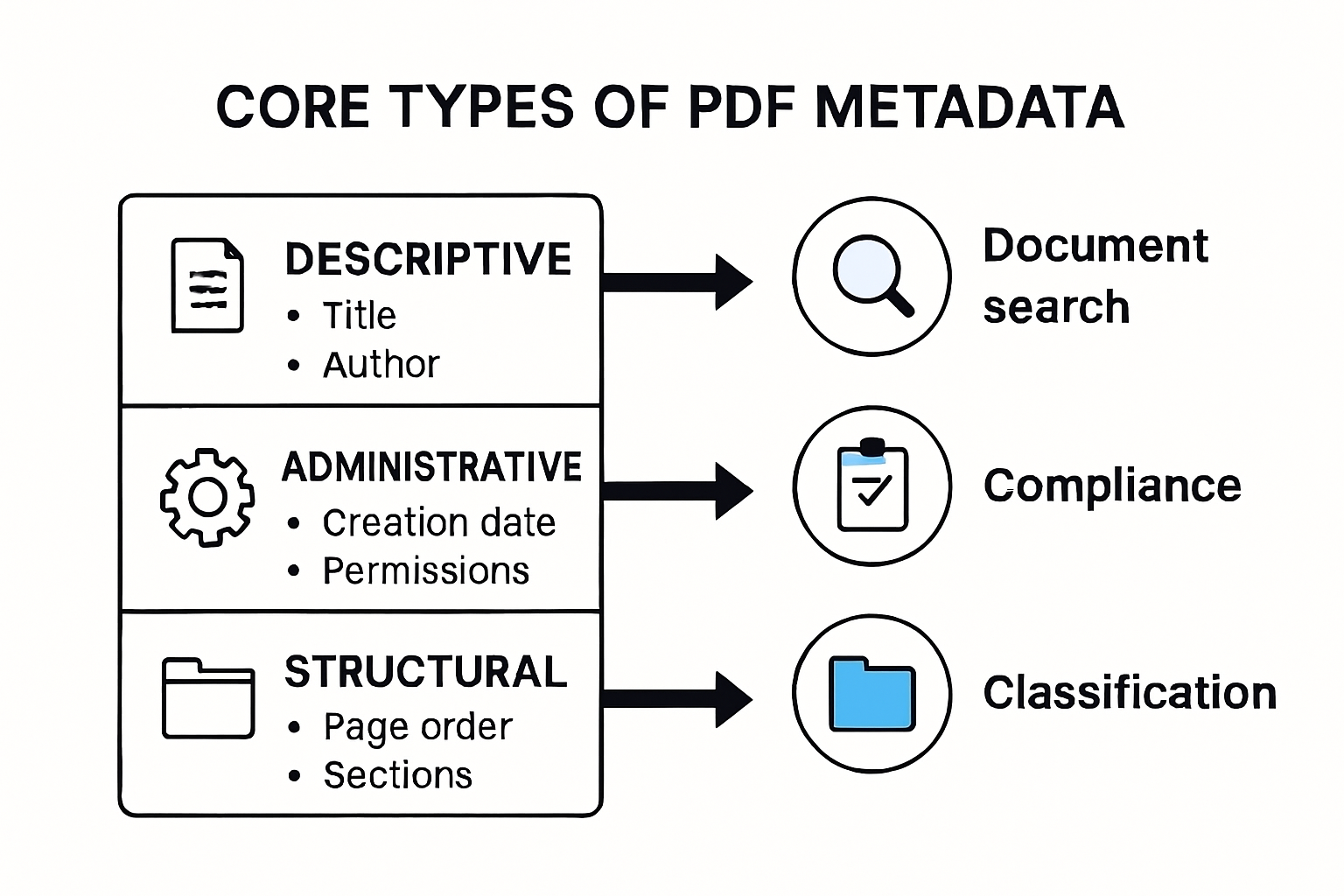PDF documents are everywhere in business, but most people only see the text on the page. Hidden behind every PDF is a layer packed with details like who made the file, when it was changed, and which software was used. The real surprise is that metadata can supercharge search, automate workflows, and even help companies meet strict compliance rules, all without anyone noticing. Ignoring metadata means missing out on one of the smartest tools for managing digital documents.
Table of Contents
- Defining Metadata In Pdf Documents
- The Importance Of Metadata In Business Workflows
- How Metadata Enhances Pdf Document Management
- Key Concepts Of Metadata In Pdf And Their Applications
Quick Summary
| Takeaway | Explanation |
|---|---|
| Metadata is essential for PDF management | It provides critical context about documents, enhancing tracking and organization. |
| Utilize metadata for compliance and governance | Metadata enables organizations to maintain regulatory compliance and establish clear ownership. |
| Leverage metadata to enhance workflows | Intelligent use of metadata allows for automation and improves document retrieval processes. |
| Classify documents through advanced metadata | Implementing metadata categorizes documents efficiently, facilitating better search and organization. |
| Transform PDFs into intelligent assets | View PDFs not just as files but as dynamic resources that drive operational efficiency and insights. |
Defining Metadata in PDF Documents
Metadata represents the hidden descriptive information embedded within PDF documents that provides critical context about the file itself. Unlike visible content, metadata operates behind the scenes, offering insights into document properties, creation details, and administrative information that are essential for businesses managing digital documentation.
Understanding the Core Components of PDF Metadata
PDF metadata typically encompasses several key elements that capture comprehensive details about a document:
- Document Creator: Information about the individual or system that originally generated the PDF
- Creation and Modification Dates: Precise timestamps indicating when the document was first created and subsequently altered
- Author Details: Name or organizational identifier associated with document production
- Software Used: The specific application or tool employed in PDF generation
These background details serve multiple strategic purposes for organizations. Metadata enables efficient document tracking, supports version control processes, and provides transparency regarding document provenance and handling.
The Business Significance of PDF Metadata Management
For enterprise environments, metadata management transcends simple record keeping. According to Gartner Research, metadata represents a critical component of digital asset management, enabling organizations to establish robust information governance frameworks.
Businesses leverage metadata for several critical objectives:
- Streamlining document search and retrieval processes
- Ensuring regulatory compliance through comprehensive tracking
- Implementing advanced security protocols
- Supporting sophisticated document workflow automation
Professional document management requires understanding metadata not just as technical information, but as a strategic asset that provides deeper insights into organizational document ecosystems. Learn more about advanced PDF metadata management to optimize your document workflows and enhance organizational efficiency.
The Importance of Metadata in Business Workflows
Metadata serves as a critical infrastructure component in modern business document management, transforming how organizations process, track, and utilize digital information. By providing rich contextual details about documents, metadata enables intelligent workflows that drive operational efficiency and strategic decision making.
Enhancing Document Governance and Compliance
In complex business environments, metadata plays a pivotal role in maintaining robust document governance frameworks. Organizations rely on metadata to:
- Establish clear document ownership and accountability
- Track document version histories and modifications
- Enforce security and access control protocols
- Support regulatory compliance requirements
By capturing granular information about document creation, modification, and usage, businesses can create transparent audit trails that withstand intense regulatory scrutiny.
Learn more about advanced PDF workflow optimization to understand how metadata can transform your document management strategies.
Strategic Workflow Optimization Through Intelligent Metadata
According to National Institute of Standards and Technology, metadata enables organizations to implement sophisticated information management strategies. Intelligent metadata utilization allows businesses to:
- Automate document routing and approvals
- Implement precise access control mechanisms
- Develop sophisticated content classification systems
- Enable rapid search and retrieval processes
By treating metadata as a strategic asset, organizations can create more responsive, agile document workflows that reduce manual intervention and minimize potential human error. The ability to programmatically understand document context transforms metadata from a passive record into an active management tool that drives operational excellence.
How Metadata Enhances PDF Document Management
Metadata transforms PDF document management from a static file storage approach to a dynamic, intelligent system that enables organizations to extract maximum value from their digital assets. By embedding rich contextual information within documents, businesses can create more sophisticated, responsive document ecosystems.
Intelligent Document Classification and Organization
Advanced metadata management allows organizations to implement sophisticated document classification strategies. Businesses can leverage metadata to:
- Automatically categorize documents based on content attributes
- Create hierarchical document repositories
- Enable precise filtering and search capabilities
- Implement granular access control mechanisms
These classification capabilities go beyond simple file naming conventions, providing a comprehensive framework for document management that adapts to complex organizational structures and workflow requirements.
Security and Compliance Through Metadata Intelligence
According to Federal Geographic Data Committee, metadata serves as a critical component in ensuring document security and regulatory compliance. Metadata enables organizations to:
- Track document access and modification history
- Implement role based document permissions
- Create transparent audit trails
- Detect unauthorized document alterations
By transforming metadata from passive record keeping to an active security mechanism, businesses can develop more robust information governance strategies.
The following table outlines key business applications of PDF metadata, linking each use case to its practical benefit for organizations:
| Application Area | Example Business Benefit |
|---|---|
| Search & Retrieval | Quickly locate specific documents based on metadata |
| Compliance | Maintain transparent audit trails to meet regulations |
| Security | Enforce access controls and track document changes |
| Workflow Automation | Route documents automatically for review or approval |
| Classification & Organization | Efficiently group and manage documents |

Explore advanced PDF metadata management techniques to enhance your document security protocols.
The strategic application of metadata represents a paradigm shift in document management. Instead of viewing PDFs as static files, organizations can now treat them as dynamic, intelligent assets that provide continuous insights into organizational information workflows.
Key Concepts of Metadata in PDF and Their Applications
Metadata in PDF documents represents a sophisticated information architecture that goes far beyond simple file properties. These embedded details provide a comprehensive digital fingerprint of documents, enabling organizations to transform passive files into intelligent, manageable information assets.
Core Types of PDF Metadata
PDF metadata can be categorized into distinct yet interconnected types that serve specific organizational purposes:
- Descriptive Metadata: Captures document identification details like title, author, keywords
- Administrative Metadata: Tracks document creation, modification, access permissions
- Structural Metadata: Defines document relationships, page organization, and internal hierarchies
Each metadata type contributes unique insights that collectively enhance document understanding and management. By integrating these metadata dimensions, businesses can create more nuanced, context aware document management strategies.
To help clarify the different types of PDF metadata and what each includes, here is a table summarizing the core categories discussed in the article:
| Metadata Type | Purpose | Examples |
|---|---|---|
| Descriptive Metadata | Identifies and describes the document | Title, Author, Keywords |
| Administrative Metadata | Tracks creation, modification, and permissions | Creation Date, Modification Date, Access Permissions |
| Structural Metadata | Defines internal structure and organization | Page Order, Document Sections, Hierarchical Relationships |

Strategic Applications in Enterprise Environments
According to National Center for Education Statistics, metadata serves as a critical infrastructure for understanding and managing digital information. Enterprise applications of PDF metadata include:
- Implementing advanced document search capabilities
- Automating compliance and governance workflows
- Enabling precise access control mechanisms
- Supporting comprehensive digital archiving strategies
Explore advanced PDF metadata management techniques to unlock the full potential of your digital document ecosystem. By treating metadata as a strategic asset, organizations can transform PDF documents from static files into dynamic, intelligent resources that drive operational efficiency and informed decision making.
Ready to Take Control of Your PDF Metadata?
Businesses today face growing challenges managing complex document workflows and ensuring accurate metadata across large PDF collections. As described in the article, incomplete or inconsistent metadata can disrupt searchability, workflow automation, regulatory compliance, and overall information integrity. If you have ever struggled to track document changes, ensure security, or keep up with compliance requirements, you already know the critical impact metadata has on your business.

At Mapsoft.com we empower organizations to streamline PDF management and elevate document intelligence. Our specialized PDF solutions allow you to edit metadata, automate batch processes, and implement advanced access controls right from your everyday Adobe tools. You can refine and control every aspect of your PDF assets by integrating intelligent metadata management straight into your operational workflows. See how Mapsoft PDF Hub can help you unlock powerful automation, smarter classification, and regulatory confidence today. Explore our solutions now and transform the way your business handles digital documents.
Frequently Asked Questions
What is PDF metadata and why is it important for businesses?
PDF metadata is hidden information embedded within a PDF document that provides context about the file, such as the document creator, creation and modification dates, author details, and software used. It is important for businesses because it aids in document tracking, ensures regulatory compliance, and enhances document governance.
How can businesses use metadata to streamline their document workflows?
Businesses can use metadata to automate document classification, enable precise search and retrieval processes, implement access control mechanisms, and maintain clear version histories. This results in more efficient workflows and improved operational efficiency.
What are the different types of PDF metadata?
The different types of PDF metadata include descriptive metadata (captures document identification details like title and author), administrative metadata (tracks creation and modification details), and structural metadata (defines relationships within the document and page organization).
How does metadata enhance document security and compliance?
Metadata enhances document security by tracking access and modification histories and implementing role-based permissions. It also creates transparent audit trails that support compliance with regulatory requirements, ensuring accountability and security in document management.
Recommended
- Editing PDF Metadata for Unlocking Success Tips
- PDF Structure Analysis for Businesses and IT Teams –
- Why Use PDF Format for Business Document Management –
- Unlock the Benefits: Why Use PDF Format for Business
Metadata in PDF documents Conclusion
Effective use of metadata in pdf documents ensures compliance and improves document governance.
Many organizations overlook the benefits of metadata in pdf documents, leading to inefficiencies.
Understanding the role of metadata in pdf documents is crucial for businesses. With effective metadata in pdf documents, organizations can streamline their operations.



